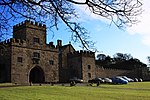Samlesbury Hall

Samlesbury Hall is a historic house in Samlesbury, Lancashire, England, six miles (10 km) east of Preston. It was built in 1325 by Gilbert de Southworth (b. 1270), and was the primary home of the Southworth family until the early 17th century. Samlesbury Hall may have been built to replace an earlier building destroyed during a raid by the Scots, during The Great Raid of 1322. The hall has been many things in its past including a public house and a girls' boarding school, but since 1925, when it was saved from being demolished for its timber, it has been administered by a registered charitable trust, the Samlesbury Hall Trust. This Grade I listed medieval manor house attracts more than 50,000 visitors each year.Samlesbury Hall is open to the public daily except on Saturdays.
Excerpt from the Wikipedia article Samlesbury Hall (License: CC BY-SA 3.0, Authors, Images).Samlesbury Hall
South Ribble Samlesbury
Geographical coordinates (GPS) Address Nearby Places Show on map
Geographical coordinates (GPS)
| Latitude | Longitude |
|---|---|
| N 53.7695 ° | E -2.5727 ° |
Address
PR5 0UP South Ribble, Samlesbury
England, United Kingdom
Open on Google Maps










